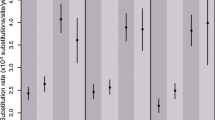Abstract
We investigated the selection pressures on the haemagglutinin genes of H5N1 avian influenza viruses using fixed effects likelihood models. We found evidence of positive selection in the sequences from isolates from 1997 to 2007, except viruses from 2000. The haemagglutinin sequences of viruses from southeast Asia, Hong Kong and mainland China were the most polymorphic and had similar nonsynonymous profiles. Some sites were positively selected in viruses from most regions and a few of these sites displayed different amino acid patterns. Selection appeared to produce different outcomes in viruses from Europe, Africa and Russia and from different host types. One position was found to be positively selected for human isolates only. Although the functions of some positively selected positions are unknown, our analysis provided evidence of different temporal, spatial and host adaptations for H5N1 avian influenza viruses.
Similar content being viewed by others
References
Bush R M, Fitch W M, Bender C A, et al. Positive selection on the H3 hemagglutinin gene of human influenza virus A. Mol Biol Evol, 1999, 16: 1457–1465, 10555276, 1:CAS:528:DyaK1MXntlGqu7c%3D
Webster R G, Bean W J, Gorman O T, et al. Evolution and ecology of influenza A viruses. Microbiol Rev, 1992, 56: 152–179, 1579108, 1:STN:280:By2B2M3nvFM%3D
Yamada S, Suzuki Y, Suzuki T, et al. Haemagglutinin mutations responsible for the binding of H5N1 influenza A viruses to human-type receptors. Nature, 2006, 444: 378–382, 17108965, 10.1038/nature05264, 1:CAS:528:DC%2BD28Xht1Sgtb7J
Fitch W M, Leiter J M E, Li X, et al. Positive Darwinian evolution in human influenza A viruses. Proc Natl Acad Sci USA, 1991, 88: 4270–4274, 1840695, 10.1073/pnas.88.10.4270, 1:CAS:528:DyaK3MXkt1Grtrw%3D
Ina Y, Gojobori T. Statistical analysis of nucleotide sequences of the hemagglutinin gene of human influenza A viruses. Proc Natl Acad Sci USA, 1994, 91: 8388–8392, 8078892, 10.1073/pnas.91.18.8388, 1:CAS:528:DyaK2cXlvFOjs7Y%3D
Campitelli L, Ciccozzi M, Salemi M, et al. H5N1 influenza virus evolution: a comparison of different epidemics in birds and humans (1997–2004). J Gen Virol, 2006, 87: 955–960, 16528045, 10.1099/vir.0.81397-0, 1:CAS:528:DC%2BD28XjsVWhu74%3D
Smith G J, Naipospos T S P, Nguyen T D. et al. Evolution and adaptation of H5N1 influenza virus in avian and human hosts in Indonesia and Vietnam. Virology, 2006, 350: 258–268, 16713612, 10.1016/j.virol.2006.03.048, 1:CAS:528:DC%2BD28Xmt1Gkt74%3D
Ciccozzi M, Montieri S, Facchini M, et al. Evolutionary analysis of HA and NS1 genes of H5N1 influenza viruses in 2004–2005 epidemics. Avian Dis, 2007, 51(1 Suppl): 455–460, 17494606, 10.1637/7620-042606R.1
Nielsen R. Mapping mutations on phylogenies. Syst Biol, 2002, 51(5): 729–739, 12396587, 10.1080/10635150290102393
Suzuki Y, Gojobori T. A method for detecting positive selection at single amino acid sites. Mol Biol Evol, 1999, 16: 1315–1328, 10563013, 1:CAS:528:DyaK1MXms1Ojt70%3D
Huelsenbeck J P, Dyer K A. Bayesian estimation of positively selected sites. J Mol Evol, 2004, 58: 661–672, 15461423, 10.1007/s00239-004-2588-9, 1:CAS:528:DC%2BD2cXkvVOiu7k%3D
Nielsen R, Yang Z H. Likelihood models for detecting positively selected amino acid sites and applications to the HIV-1 envelope gene. Genetics, 1998, 148: 929–936, 9539414, 1:CAS:528:DyaK1cXks1eitr8%3D
Yang Z H, Nielsen R, Goldman N, et al. Codon-substitution models for heterogeneous selection pressure at amino acid sites. Genetics, 2000, 155: 431–449, 10790415, 1:CAS:528:DC%2BD3cXjslKhtb4%3D
Kosakovsky Pond S L, Frost S D W. Not so different after all: A comparison of methods for detecting amino acid sites under selection. Mol Biol and Evol, 2005, 22: 1208–1222, 10.1093/molbev/msi105
Suzuki Y. New methods for detecting positive selection at single amino acid sites. J Mol Evol, 2004, 59: 11–19, 15383903, 1:CAS:528:DC%2BD2cXlsleisLc%3D
Yang Z, Swanson W. Codon-substitution models to detect adaptive evolution that account for heterogeneous selective pressures among site classes. Mol Biol Evol, 2002, 19(1): 49–57, 11752189
Kosakovsky Pond S L, Frost S D W. Datamonkey: rapid detection of selective pressure on individual sites of codon alignments. Bioinformatics, 2005, 21(10): 2531–2533, 10.1093/bioinformatics/bti320
Thompson J D, Gibson T J, Plewniak F, et al. The CLUSTAL_X windows interface: Flexible strategies for multiple sequence align ment aided by quality analysis tools. Nucl Acids Res, 1997, 25: 4876–4882, 9396791, 10.1093/nar/25.24.4876, 1:CAS:528:DyaK1cXntFyntQ%3D%3D
Guindon S, Gascuel O. A simple, fast, and accurate algorithm to estimate large phylogenies by maximum likelihood. Syst Biol, 2003, 52: 696–704, 14530136, 10.1080/10635150390235520
Kosakovsky Pond S L, Frost S D W, Muse S V. HyPhy: hypothesis testing using phylogenies. Bioinformatics, 2005, 21: 676–679, 10.1093/bioinformatics/bti079
Hasegawa M, Kishino H, Yano T A. Dating of the human ape splitting by a molecular clock of mitochondrial-DNA. J Mol Evol, 1985, 22: 160–174, 3934395, 10.1007/BF02101694, 1:CAS:528:DyaL2MXmtFSns7g%3D
Muse S V, Gaut B S. A likelihood approach for comparing synonymous and nonsynonymous nucleotide substitution rates, with application to the chloroplast genome. Mol Biol Evol, 1994, 11: 715–724, 7968485, 1:CAS:528:DyaK2cXlvFOjsL8%3D
Normile D. Avian influenza: Evidence points to migratory birds in H5N1 spread. Science, 2006, 311: 1225, 16513949, 10.1126/science.311.5765.1225, 1:CAS:528:DC%2BD28XitV2gsb8%3D
Webby R, Hoffmann E, Webster R. Molecular constrains to interspecies transmission of viral pathogens. Nature Med, 2006, 10: S77–S81
Kaverin N V, Rudneva I A, Ilyushina N A, et al. Structure of antigenic sites on the haemagglutinin molecule of H5 avian influenza virus and phenotypic variation of escape mutants. J Gen Virol, 2002, 83: 2497–2505, 12237433, 1:CAS:528:DC%2BD38XnsFKgu7c%3D
Gambaryan A, Yamnikova S, Lvov D, et al. Receptor specificity of influenza viruses from birds and mammals: New data on involvement of the inner fragments of the carbohydrate chain. Virology, 2005, 334: 276–283, 15780877, 10.1016/j.virol.2005.02.003, 1:CAS:528:DC%2BD2MXisVCltbg%3D
Ilyushina N A, Rudneva I A, Gambaryan A S, et al. Receptor specificity of H5 influenza virus escapemutants. Virus Res, 2004, 100: 237–241, 15019242, 10.1016/j.virusres.2003.12.032, 1:CAS:528:DC%2BD2cXhs12ls7c%3D
Wallace R G, HoDac H, Lathrop R H, et al. A statistical phylogeography of influenza A H5N1. Proc Natl Acad Sci USA, 2007, 104: 4473–4478, 17360548, 10.1073/pnas.0700435104, 1:CAS:528:DC%2BD2sXjsFKnsbs%3D
Author information
Authors and Affiliations
Corresponding authors
Rights and permissions
About this article
Cite this article
Shi, W., Gibbs, M.J., Zhang, Y. et al. The variable codons of H5N1 avian influenza A virus haemagglutinin genes. SCI CHINA SER C 51, 987–993 (2008). https://doi.org/10.1007/s11427-008-0131-8
Received:
Accepted:
Published:
Issue Date:
DOI: https://doi.org/10.1007/s11427-008-0131-8




